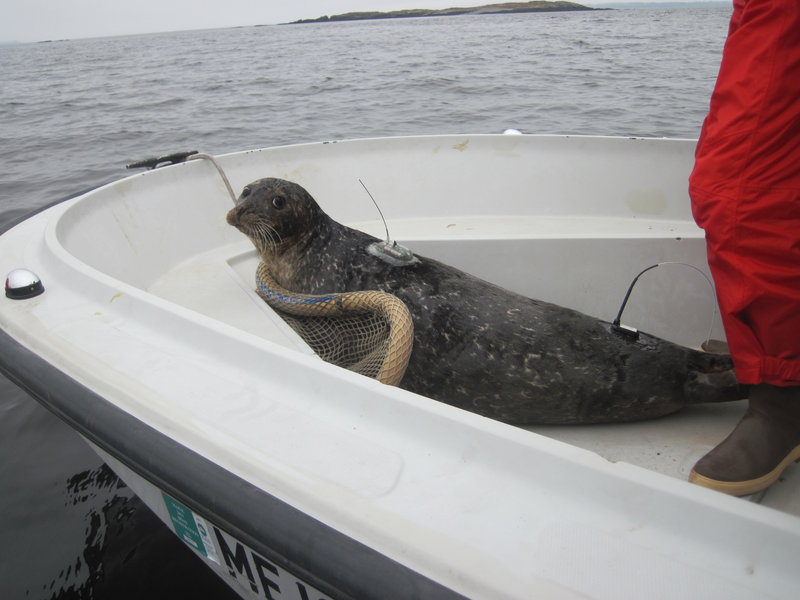Hunting seals off the Maine coast is a bit like herding cats.
That’s what a group of researchers were finding last week in Penobscot Bay. The researchers are attempting to capture, then tag harbor seals for the first comprehensive study of the species in a decade.
The seals descend on Maine from up and down the East Coast in the spring to have their pups on the state’s tidal ledges and islands, presenting the perfect opportunity to count them and assess their health.
But catching them isn’t easy. After four nine-hour days, the researchers had tagged a grand total of three seals.
“Seals are very clever,” said Gordon Waring, head of the seal research program at the Woods Hole Laboratory of the National Oceanic and Atmospheric Administration’s Northeast Fisheries Science Center in Massachusetts.
Waring said the survey will help scientists determine how the population is faring and whether the number of seals unintentionally killed by humans, such as those caught in the nets of ground fishermen, are reaching unsustainable levels.
New England’s population of harbor seals dropped severely in the early 1900s because of bounty programs in Maine and Massachusetts. Seals, which eat fish and crustaceans, have traditionally been considered a competitor and a pest by fishermen.
Maine stopped its program in 1905 while Massachusetts kept its program going until 1962. The species is now protected by the Marine Animal Protection Act of 1972.
By the mid-1970s, at the time of the first comprehensive survey, the population had dwindled to about 5,500.
Since then the species has bounded back. The last survey in 2001 estimated the population at just under 100,000 and growing at about 6.5 percent annually.
Adult harbor seals have no major predators, although killer whales off Canada may hunt them, said Waring. But the pups are preyed on by eagles and possibly coyotes. The mortality rate is about 20 to 30 percent in their first year but drops dramatically after that.
Scientists do not know how much longer the population will continue to grow, said Waring, but the results of this year’s survey may hold some clues.
The work is funded by about $110,000 in federal money. Waring said some of the equipment has been donated and many of the researchers from a half-dozen organizations, including the University of Maine, are volunteering their time.
Every day last week, a team of eight to 12 people headed out from Rockland to the tidal ledges and islands that serve as popular seal haul-outs.
Using 500-foot-long gill nets that reach about 15 feet deep, the researchers carefully approached the wary seals, which plunged back into the water as the boats near. Waring said the hope is that some of the seals will swim into the net. They rarely do.
“Most times we have zero. Then they come back and hang around the boats, bobbing around us and playing around,” said Waring.
Any seal they catch is quickly pulled into the boat and coaxed into a small hoop net for weighing and measuring. Designated seal “sitters” apply pressure to the seal’s back to calm it. The seals, some reaching a weight of more than 200 pounds of blubber and muscle, are feisty and prone to bite.
Separate radio and satellite tags are attached to the seal’s back with epoxy. A blood sample and a small snip of skin tissue is taken for genetic testing. The whole process takes about a half-hour, and then the seal is released.
Waring said overall the seals appear fat, energetic and healthy.
Aerial surveys scheduled for around May 21 in Maine will be able to pick up the signals of the tagged seals which will allow the scientists to more accurately estimate the population. The tags will be shed by the seals when they molt in a couple of months.
The researchers managed to tag 14 harbor seals in Chatham, Mass., earlier this month, along with two released from captivity after being rehabilitated.
Keith Matassa, coordinator at the University of New England Marine Animal Rehabilitation Center in Biddeford, said the project is important to an understanding of what is going on in the marine environment.
The Biddeford center rehabilitated 125 harbor seals last year and already has six harbor pups born prematurely this spring. Normally the center has one or two a year, said Matassa, who helped in the capture effort off Rockland last week.
“These seals tell us what is affecting them,” said Matassa.
Matassa said antibiotic resistance among harbors seals, which are subject to pneumonia, has risen and not because they are receiving antibiotics intentionally. He said seals can harbor intestinal parasites that can be passed to humans swimming near them.
“So there are health issues that can affect humans,” said Matassa.
Staff Writer Beth Quimby can be contacted at 791-6363 or at:
bquimby@pressherald.com
Send questions/comments to the editors.




Success. Please wait for the page to reload. If the page does not reload within 5 seconds, please refresh the page.
Enter your email and password to access comments.
Hi, to comment on stories you must . This profile is in addition to your subscription and website login.
Already have a commenting profile? .
Invalid username/password.
Please check your email to confirm and complete your registration.
Only subscribers are eligible to post comments. Please subscribe or login first for digital access. Here’s why.
Use the form below to reset your password. When you've submitted your account email, we will send an email with a reset code.